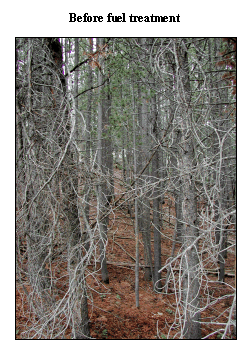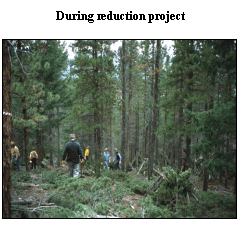
- Afghanistan
- Africa
- Budget Management
- Defense
- Economy
- Education
- Energy
- Environment
- Global Diplomacy
- Health Care
- Homeland Security
- Immigration
- International Trade
- Iraq
- Judicial Nominations
- Middle East
- National Security
- Veterans
|
Home >
News & Policies >
Policies in Focus
|
Healthy Forest : An Initiative for Wildfire Prevention and Stronger Communities
Overview: Current Efforts to Control Wildfires and Restore Forest Health
- Firefighters are effective in part because of additional federal resources provided for both firefighting and forest health programs.
- A comprehensive 10-year strategy to make communities safer from wildfires.
- The Administration is working to prevent future large, catastrophic fires by carrying out fuel treatment programs such as thinning and prescribed burning.
- Fuel treatment projects have prevented or stopped fires.
- Fuel Reduction in Rocky Mountain National Park
- The Administration is working to make its fuels treatment and forest health programs even more effective.
- The Administration is restoring record amounts of burned forests and rangelands.
- The Administration is providing more thatn $428 million in fire prevention, prepardness, and suppression assistance this year to thousands of communities.
- Student Conservation Association volunteers have enlisted in the fight against wildfires.
Faced with conditions that are ripe for catastrophic and uncontrollable fires, firefighters are doing an outstanding job this year, controlling over 99 percent of wildfires on initial attack. (For example, on July 14, 504 new fires started, but only five grew to burn more than 500 acres). In this fire season alone, more than 500 large fires have already been contained. But when fires escape initial efforts to control them, they can become uncontrollable, costly and environmentally destructive.
Although firefighting efforts are largely effective, they are dangerous, uncertain,
and expensive.
The real solution to catastrophic wildfires is to address their causes by reducing
fuel hazards and returning our forests and rangelands to healthy conditions.
Tree thinning and removal of dense underbrush can ensure thriving forests while
reducing risks of catastrophic fires and the dangers they pose to firefighters.
A comprehensive 10-year strategy to make communities safer from wildfires.
On May 23, 2002, Secretary Norton and Secretary Veneman signed an historic agreement with 17 western governors, county commissioners, state foresters, and tribal officials on a plan to make communities and the environment safer from wildfires through coordinating federal, state, and local action.
Under the 10-year Comprehensive Strategy Implementation Plan, federal wildfire agencies, affected states, counties, local governments and tribes agreed to the same goals, implementation outcomes, performance measures and tasks that need to be accomplished by specific deadlines. The comprehensive agreement covers all phases of the fire program, including fire preparedness, suppression and prevention, hazardous fuels management, restoration of burned areas, community assistance, and monitoring of progress.
A key priority of the plan is more active forest and rangeland management to reduce the accumulation of fuels and to restore ecosystem health.
The plan specifically calls for active forest and rangeland management, including thinning of forests and rangelands that produce forest by-products, biomass removal and utilization, and other tools that will meet long-term ecological, economic, and community objectives. (For examples of this work, see photographs on next page.)
The plan also establishes 23 priority tasks for federal, state, and local governments, including:
The Forest Service and Interior Department are planning to treat more 2.5 million acres of land this year with thinning or prescribed burns that reduce the accumulation of hazardous fuels and restore forest health. At the beginning of August last year, these agencies had treated 1,573,000 acres. This year, the agencies have already treated 459,000 acres more than last year - a nearly 30 percent increase.
Fuels treatment projects have prevented or stopped fires.
Fuel Reduction in Rocky Mountain National Park
 |
 |
 |
|
The Administration is working to make its fuels treatment and forest health
programs even more effective.
Actions taken to improve the programs include:
- A Cohesive Fuels Treatment Strategy for all Forest Service and the Department
of the Interior agencies is being developed that places a priority on selecting
projects where the risk of catastrophic fires to communities and ecosystems
is the greatest.
- Forest Service, Interior, state, local and tribal officials are working
together to jointly select and prioritize fuels treatment projects.
- The process for selecting final fuels treatment projects has been accelerated
to October of each year to make better use of fall and winter prescribed fire
conditions.
- A common reporting system has been developed for fuels treatment projects across all agencies.
- The Department of the Interior has appointed a full-time fuels treatment
director to insure accountability for fuel treatment projects.
- The Forest Service and the Department of the Interior are developing
common performance measures that are consistent with the Government Performance
and Results Act and are outcome oriented.
- The agencies are including implementation of the National Fire Plan as an element in annual performance evaluations of field staff, and specifically including staff's effectiveness in completing required fuels treatment work.
The Administration is restoring record amounts of burned forests and rangelands.
The Forest Service, Department of the Interior and the Federal Emergency Management Administration provide funding for equipment, personnel, training, community hazard mitigation plans, market utilization of small diameter materials, fuels reduction projects, and cost reimbursement to thousands communities and local, rural and volunteer fire departments. These agencies are writing a memorandum of understanding to better coordinate all future grants given to communities.
Federal assistance is supporting volunteer firefighting and forest health efforts.
In the last two years, there has been an increase in federal assistance and support to rural and volunteer fire departments, which in turn respond to fires on federal lands. Volunteer and rural fire departments are the first line of initial attack in up to 90 percent of all wildfires. Federal assistance has improved rural and volunteer fire departments' capabilities by providing personal protective gear, equipment, and training. Last year, more than 12,000 volunteer and municipal firefighters received federal training, and more than 40 new volunteer fire departments were organized.
Student Conservation Association volunteers have enlisted in the fight against
wildfires.
Student Conservation Association volunteers are also doing vital work on many forest health restoration and fire safety education projects. Recognizing the urgency of the wildfire threat, SCA has quadrupled the number of volunteers providing fire-related services in the last year. SCA has enlisted hundreds of volunteers to assist property owners along the wildland-urban interface in identifying and implementing strategies for protecting their homes and properties from wildland fires. SCA volunteers conduct fire audits in rural communities, help homeowners create defensible space around their homes, and work to reduce fuel loads and remove invasive species. SCA volunteers give over one million hours of service each year to ensure the health of America's forests, parks and wild lands.


